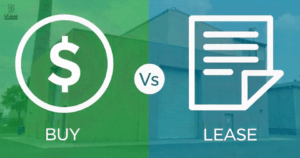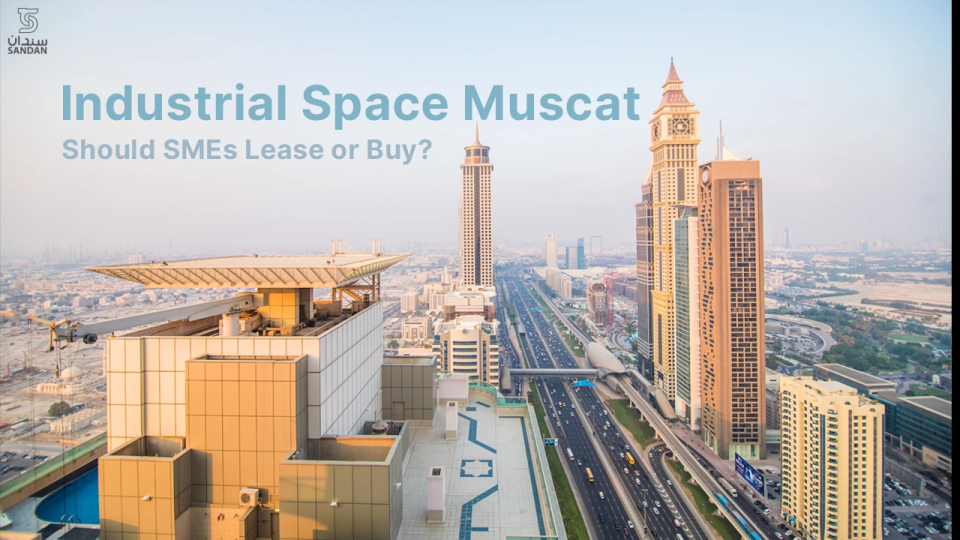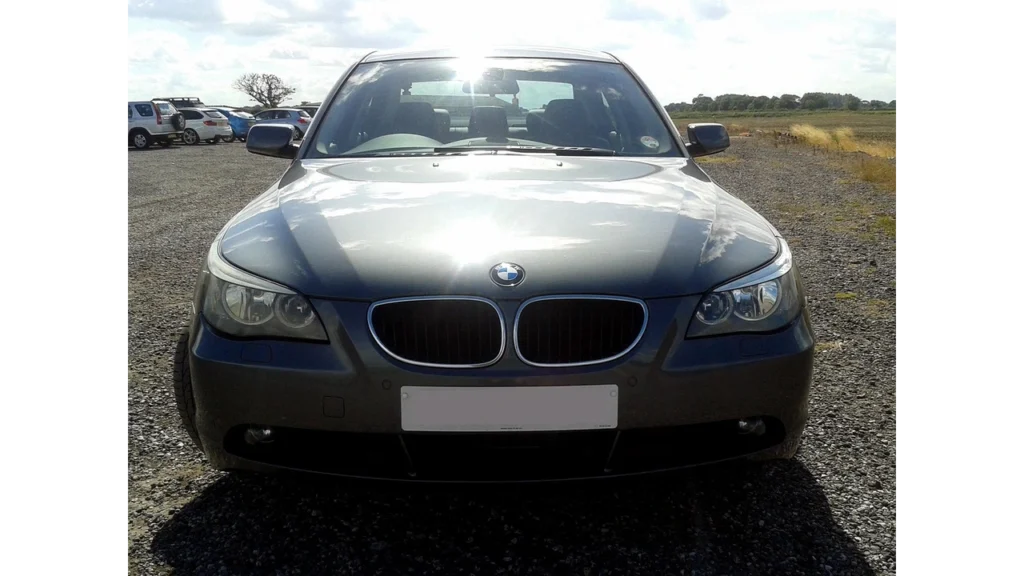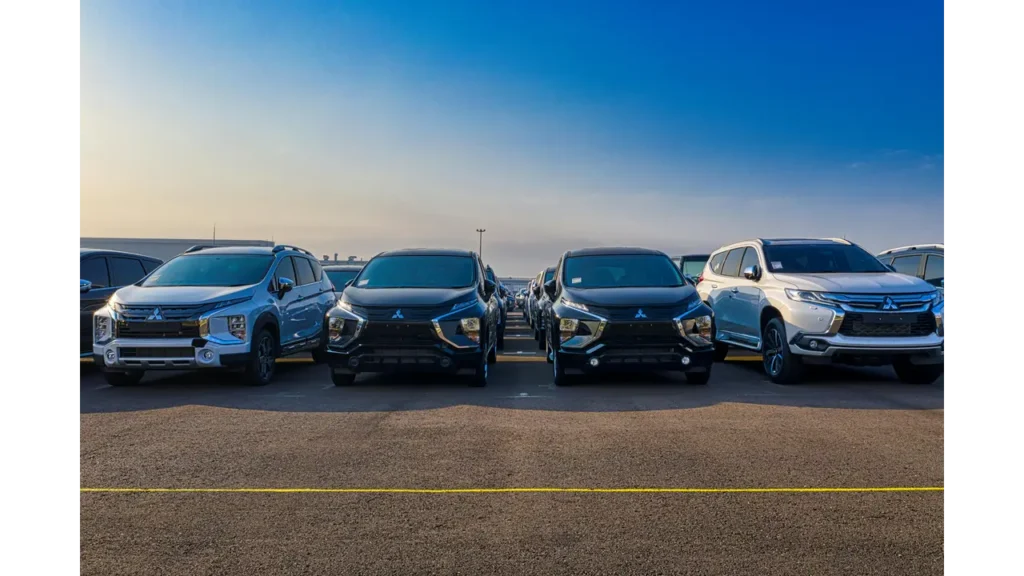Introduction
Looking for industrial space Muscat and wondering whether it makes more sense to keep renting or finally buy a unit of your own? You are not alone. Since Royal Decree 38/2025 gave foreign-owned companies the green light to purchase freehold property inside Oman’s special economic and industrial zones, the age-old “lease or buy” debate has taken on a new urgency. Market reports show warehouse and workshop rents creeping upward again this year, while sale prices in emerging hubs such as Sandan Industrial City remain surprisingly accessible. Taken together, these shifts mean small-to-mid-sized manufacturers now have a real choice: stay on the landlord’s clock or convert rent cheques into equity.
Snapshot of what you’ll learn
- How Muscat’s current lease rates stack up against today’s freehold asking prices
- The true, line-item cost of leasing versus buying—deposits, registration fees, fit-out and more
- Cash-flow break-even timelines that resonate with SME budgets
- Financing routes, from Sandan’s zero-interest instalment plan to Islamic ijara mortgages
- A quick decision matrix and downloadable calculator to help you pick the right model for your business
- Why the lease-or-buy question is suddenly urgent
Twelve months ago, every SME I spoke to in Muscat treated rent as a fact of life—just another overhead alongside electricity and payroll. Then Royal Decree 38/2025 landed, rents in hot spots like Ghala crept up again, and lenders rolled out small-ticket Islamic ijara packages. Put those three trends together and the safe, familiar choice (leasing) no longer looks automatically cheaper or more flexible than owning.
Across the capital, industrial rents rose roughly five percent over the past year, while finished workshops in Sandan Industrial City are changing hands for what many businesses currently burn on lease deposits and fit-out. A weak OMR that’s pegged to the US dollar also keeps mortgage repayments steady for UAE-dirham earners. Translation: the math you did even six months ago is probably outdated.
- Muscat market snapshot: prices, vacancy and where industrial space Muscat is still a bargain
| Zone | Typical rent band (OMR /m² / month) | Typical sale band (OMR /m²) | Vacancy trend | Quick take |
| Ghala | 2.0 – 3.0 | 600 – 900 | Tight | Central logistics, older stock |
| Rusayl | 1.8 – 2.5 | 550 – 850 | Stable | Power-heavy users, 30 km out |
| Khazaen | 1.5 – 2.0 | 450 – 700 | Rising | Greenfield SEZ with incentives |
| Sandan | 2.7 – 3.3 (small units) | 630 – 700* | Low | Buy-to-occupy momentum |
*Example: two-storey 55 m² workshop listed at 35 000 OMR ≈ 645 OMR /m².
What jumps out is the shrinking gap between five-year lease commitments and all-in purchase prices—especially in Sandan, where new stock arrives with utilities in place and an 18-month, zero-interest payment plan. If your business expects to stay in one footprint longer than four or five years, ownership now deserves a serious look.
- Lease vs buy at a glance
Here is the 60-second overview most owners want before they wade into spreadsheets:
| Question | Leasing | Buying/Freehold |
| Up-front cash | 5-month rent deposit plus first rent cheque | 30–40 % down payment or 5 % booking fee if using Sandan’s instalment plan |
| Monthly cash-flow hit | Pure operating expense that rises with annual escalators | Instalment or mortgage that can be equal to—or lower than—the going rent |
| Balance-sheet impact | Off-balance for some SMEs under IFRS-16 thresholds | Capital asset you can depreciate or pledge for working-capital loans |
| Exit options | Walk away after lease ends (lose deposit if early) | Sell, sub-lease or mortgage the deed whenever markets turn ✔ |
| Five-year total cost* | About 82 000 OMR for a 500 m² Ghala lease | About 40 000 OMR net for a 55 m² Sandan workshop, including fees |
*Based on 2.5 OMR / m² rent with 5 % annual escalation vs 35 000 OMR sale price with 3 % registration and utility deposits.
If your operation will stay put at least five years, the table already hints that ownership deserves serious thought.
- The hidden cost stack in a lease for industrial space Muscat
Landlords quote a base rent that looks affordable until the extras pile on. Watch for these three line items:
- Security deposit: five months of rent locked up interest-free for your landlord.
- Municipal tax: another five percent layered onto every rent cheque.
- Escalation clause: two-to-five-percent annual increase that compounds quickly.
Example: a 500 m² warehouse in Ghala at 2.5 OMR / m² starts at 15 000 OMR per year. Add the deposit and tax and your Year-1 cash outflow is roughly 23 000 OMR. Stretch that over five years with a modest five-percent escalator and you have paid more than 82 000 OMR—and still own nothing at the end.
Understanding this real cost picture is the first step toward deciding whether leasing truly keeps more money in your business.
- The real-world economics of buying a unit outright
Buying isn’t just swapping rent for a mortgage; it changes how cash leaves—and later re-enters—your business.
Land and unit price
: Finished workshops at Sandan are still trading around 35 000 OMR for a two-storey, 55 m² footprint. That sticker already includes finished floors, utilities to the door, and shared parking. Larger shells in Rusayl and Khazaen run 450–700 OMR / m² depending on power load and crane capacity.
Deed registration
: One-time Ministry of Justice fee set at three percent of the declared value (≈1 050 OMR on our 35 k unit) plus a 10 OMR stamp.
Utility deposits : Roughly 1.5 OMR per kVA for electricity and a flat 200 OMR for water—about 450 OMR total for a light-engineering shop.
Fit-out
: Concrete floor sealing, mezzanine, bus-bar trunking and a basic sprinkler loop add 80–120 OMR / m². Because you own the building, every rial you invest shows up as an asset that can be depreciated.
Annual holding cost
: Sandan’s service charge averages 0.75 OMR / m²—significantly below what most Muscat landlords recoup through service-charge mark-ups on leased space.
Add it all up and your first-two-year cash outlay hovers near 40 000 OMR—almost the same money a 500 m² tenant spends just to keep a leased warehouse for five years. The difference is you hold paper that can produce rent or be sold down the line, a key advantage when you plan to stay in industrial space Muscat for the long haul.
- How to pay for ownership without straining cash flow

Sandan zero-interest plan
: Put down 60 percent at contract signing, then clear the balance over 18 months with no finance charge. If you reserve early, that down payment can be as low as 5 percent, giving you breathing space to line up working-capital funding.
Islamic ijara and conventional mortgages
: Local banks such as Bank Muscat and Ahli Islamic now lend up to 70 percent LTV on completed industrial property. Terms range from five to ten years, and monthly instalments on a 25 000 OMR loan often mirror the rent you’d otherwise hand a landlord.
Asset-backed overdraft
: Once your deed is issued, many lenders will extend a revolving overdraft against 60 percent of appraised value—handy for bridging VAT refunds or stocking raw materials.
Free-zone incentives
: Buying inside an SEZ like Khazaen or Duqm unlocks duty-free import of machinery and a multi-year break on licence fees. Savings on cap-ex can offset your first mortgage instalments entirely.
When you combine low purchase prices, phased payment schedules and bank leverage, owning industrial space Muscat no longer feels like a capital sink—it becomes a flexible funding tool that strengthens your balance-sheet instead of draining it.
- Risk and flexibility scorecard

Owning and leasing each manage uncertainty in different ways, so think through the scenarios that could hit your business over the next five years:
| Scenario | Lease outcome | Buy outcome |
| Rapid expansion | Add extra bays or relocate when lease ends; pay make-good on old unit | Lease out or sell current unit and use capital gains or rental income to fund a larger facility |
| Market downturn | Wrap up at lease expiry or negotiate a rent cut; deposit at risk if you break early | Keep operating cost-covering tenants in place, or mortgage the deed for working capital |
| Cash crunch | Ask landlord to restructure payments—may or may not agree | Arrange a top-up loan or overdraft secured on deed—banks lend up to 60 % of value |
| Exit Muscat entirely | Forfeit deposit and fit-out, then walk | Market the asset through brokers; industrial stock in Muscat typically trades in 60–120 days |
If your sector is cyclical or you expect major headcount swings, leasing still wins on raw agility. But where sales are predictable and margins improve with lower fixed costs, a deed protects you from rent spikes and turns real estate into a safety valve rather than a liability.
- Taxes, compliance and ESG incentives you shouldn’t ignore
Taxes
: Oman keeps corporate income tax at zero for non-oil SMEs, so rental income or capital gains on an owned unit are also untaxed. Lease payments, meanwhile, attract five percent VAT that you must cash-flow until refunds land.
Depreciation sweetener
: Buildings owned by companies can be depreciated at four percent a year—an accounting line that cushions profit spikes and can help with bank covenant tests.
Licensing and Omanisation
: Whether you lease or buy, you need an industrial licence (250–3 000 OMR depending on risk class) and a 20 percent Omani workforce target you can phase in over three years. Owners enjoy one advantage: licence renewals are handled through the zone’s one-stop portal, not through a landlord.
Solar and sustainability grants
: Muscat’s main industrial corridors now offer roof-top net-metering credits that slash daytime power bills up to 30 percent. Tenants require written landlord consent; deed holders can proceed as soon as Civil Defence signs off on the array.
Tick these boxes during your feasibility stage and you’ll avoid last-minute surprises that turn a bargain lease—or a great purchase—into an expensive headache.
- Mini-case study: a Sharjah machinery trader makes the switch
Basem runs a 12-person machine-tool dealership in Sharjah. When his five-year lease in Dubai Investments Park came up for renewal at AED 29 /m² (about 3 OMR/m²), he crunched the numbers on buying a unit at Sandan Industrial City instead.
- Purchase price: two-storey 55 m² workshop for 35 000 OMR, reserved with a five-percent booking fee.
- Down payment: 60 percent (21 000 OMR) at SPA signing; balance over 18 interest-free months (≈ 1 555 OMR per month).
- One-time costs: deed registration 1 050 OMR, utility deposits 450 OMR, basic fit-out 5 000 OMR.
Basem’s all-in ownership cost after two years was roughly 40 000 OMR. A similar 55 m² rental in Muscat’s Ghala area would have set him back 330 OMR per month, escalating five percent annually. By year five his lease total would top 22 000 OMR—nearly half the price of a deeded unit with real resale value.
Basem now rents out the workshop’s mezzanine for light storage at 120 OMR a month, trimming his own occupancy cost and giving him a yield cushion if market demand softens.
- Quick decision matrix and what to do next
| Question to ask | Favour lease | Favour buy |
| Will we stay in Muscat longer than 4–5 years? | No | Yes |
| Do we need more than one relocation option in the next three years? | Yes | No |
| Can we commit 30 percent of property cost up-front (or 5 percent with Sandan’s plan)? | No | Yes |
| Would a deed improve bank-loan terms or investor confidence? | No | Yes |
| Is tight cash flow a bigger worry than rising rent? | Yes | No |
If three or more answers fall in the right-hand column, owning may serve you better than leasing—especially while Sandan’s prices and payment plans remain SME-friendly.
Ready to explore? Reserve a unit on sandan.om with a five-percent booking fee, schedule a virtual walk-through, or drop by the on-site sales suite just off Muscat Expressway. In most cases the entire deed-registration visit takes less than half a day, and you can be fitting out your new industrial space Muscat within four to six weeks.
Frequently asked questions
Can I get financing before the unit is complete?
: Yes. Banks release ijara funds once construction hits about 80 percent and the provisional title deed has been issued.
Do I need a separate real-estate visa to own industrial property?
: No. Your company’s investor and staff visas are issued through the zone’s one-stop portal, whether you lease or buy.
Can I sell the unit to a non-GCC buyer later?
: Absolutely. Freehold deeds transfer at the Ministry of Justice counter in the zone. The buyer pays the same three-percent registration fee.
Are sub-leases allowed?
: Yes—provided the sub-tenant’s activity matches your industrial licence category. Upload the sub-lease for approval and pay a small admin fee.
What happens if I miss Omanisation targets?
: You’ll pay a modest levy per missing Omani worker until hiring catches up. Many SMEs partner with local training institutes to meet the quota sooner and at lower cost.












